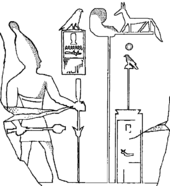Sanakht
| Sanakht | |||||||||||||||||||||
|---|---|---|---|---|---|---|---|---|---|---|---|---|---|---|---|---|---|---|---|---|---|
Turin Canon, most likely less, starting ca. 2650 BC | |||||||||||||||||||||
| Predecessor | uncertain, Sekhemkhet (most likely) or Khaba, Djoser, Khasekhemwy | ||||||||||||||||||||
| Successor | uncertain, Khaba (most likely) or Sekhemkhet, Huni, Qahedjet, Djoser | ||||||||||||||||||||
| |||||||||||||||||||||
| Father | Khasekhemwy ? | ||||||||||||||||||||
| Mother | Nimaathap ? | ||||||||||||||||||||
| Burial | mastaba K2 at Beit Khallaf? | ||||||||||||||||||||
| Dynasty | 3rd Dynasty | ||||||||||||||||||||
Sanakht (also read as Hor-Sanakht) is the
Identity
Sanakht's identity and position in the Third Dynasty is not entirely clear and remains the subject of debate. While Sanakht's existence is attested by seal fragments from

Proponents of the theory that Sanakht was nonetheless the founder of the dynasty object that the presence of Djoser's seals in Khasekhemwy's tomb only shows that Djoser conducted cultural rituals in honor of this king, and does not necessarily imply that Djoser was Khasekhemwy's immediate successor.
Presently, the dominant theory is that Sanakht's reign dates to the later Third Dynasty, after Djoser. Egyptologists Toby Wilkinson, Stephan Seidlmayer, Kenneth Kitchen and Rainer Stadelmann equate Sanakht with "Nebka", a name appearing in Ramesside king lists. In support of this theory is a clay seal fragment on which the lower part of a cartouche appears. In this cartouche Wilkinson, Seidlmayer and Stadelmann see traces of a Ka-sign, the end of the name "Nebka".[3][4] Likewise, Dietrich Wildung favors equating Nebka with Sanakht, although he questions the validity of the seal as evidence given that it is too badly damaged to read the inscription within the cartouche as "Nebka" with any certainty.[5]
John D. Degreef, Nabil Swelim and
Jürgen von Beckerath, Wolfgang Helck, Dietrich Wildung and Peter Kaplony proposed that Sanakht's Horus name is that of the shadowy Horus Sa, seeing the name "Sa" as a short form of "Sanakht".[7] From this, Wolfgang Helck holds that Sanakht's Nisut-Biti name was Weneg. King Weneg, however, is widely held to have ruled during the Second Dynasty, and Helck's theory has been greeted with skepticism.[8]
Sanakht's name was once read "Hen Nekht" by Egyptologists such as Ernest Wallis Budge. Today, this reading is not in use anymore; the up-to-date reading is "Sanakht" or (seldom) "Nakht-Sa".[9][10]
Reign

The exact duration of Sanakht's time on the throne is unknown. Unlike Djoser, few relics survive from his reign, which casts serious doubts on the traditional figure of 18 years of reign for this king, as given by both Manetho and the Turin Canon. It must be stressed that the Turin Canon and Manetho were more than one and two thousand years removed from the time of Egypt's Third Dynasty, and would be expected to contain some inaccurate or unreliable data. The Turin Canon, for instance, was transcribed on papyri that dates to the reign of the New Kingdom king, Ramesses II, who ruled Egypt from 1279–1213 BC.
Very little is known of Sanakht's activities during his reign. The presence of reliefs depicting him in the Sinai at Wadi Maghareh together with those of Djoser and Sekhemkhet suggest an important Egyptian presence there at the time of the Third Dynasty.[11] Expeditions were launched to that location for the procurement of mineral resources, in particular turquoise.
Tomb

The location of Sanakht's tomb is not known with certainty. It was long thought that Sanakht's tomb was the large mastaba K2 at Beit Khallaf, as excavations there yielded relief fragments bearing his name. However, some Egyptologists now regard this mastaba as the burial of a high official, prince or queen rather than that of a pharaoh,[12] while others continue to support the first hypothesis.[13]
In the mastaba were found the skeletal remains of a man over 1.87 m (6 ft 1+1⁄2 in) tall. According to
Consequently, the mastaba has been associated with an anecdote related by Manetho in which he tells of a late Second Dynasty king, called Sesochris, who he describes as being particularly tall. The Egyptologist Wolfgang Helck proposed another hypothesis; namely, that Sanakht's tomb is an unfinished structure west of the pyramid of Djoser.[8]
While the case of Sanakht has often appeared in the medical literature as a potential case of
See also
- List of Pharaohs
- List of Egyptian pyramids
- List of megalithic sites
References
- ISBN 0-415-18633-1, p. 83 & 95.
- ^ Illaria Incordino: The third dynasty: A historical hypothesis., in: Jean Claude Goyon, Christine Cardin: Proceedings of the Ninth International Congress of Egyptologists. p. 965, [1]
- ISBN 0-415-18633-1, p. 101 – 104.
- ISBN 063118435X, p. 534 – 538.
- ^ a b Dietrich Wildung: Die Rolle ägyptischer Könige im Bewusstsein ihrer Nachwelt. Band 1: Posthume Quellen über die Könige der ersten vier Dynastien (= Münchner ägyptologische Studien, vol. 17.). Hessling, Berlin 1969, p. 54 – 58.
- ^ a b Nabil Swelim: Some Problems on the History of the Third Dynasty., in: Archaeological and Historical Studies, The Archaeological Society of Alexandria, Alexandria 1983, pp. 95, 217–220 and 224.
- ISBN 3-8053-2591-6, p. 49, 283 & 293.
- ^ ISBN 3-447-02677-4, p. 20 & 21.
- ^ JSTOR 2839307.
- ^ Dietrich Wildung: Die Rolle ägyptischer Könige im Bewusstsein ihrer Nachwelt. Band 1: Posthume Quellen über die Könige der ersten vier Dynastien (= Münchner ägyptologische Studien, vol. 17.). Hessling, Berlin 1969, p. 54-58.
- ^ Illaria Incordino: The third dynasty: A historical hypothesis., in: Jean Claude Goyon, Christine Cardin: Proceedings of the Ninth International Congress of Egyptologists. p. 966
- ISBN 0-631-19396-0, p. 64.
- ISBN 978-3-447-06251-0, p. 145-155.
- ^ Francesco M. Galassi, Maciej Henneberg, Wouter de Herder, Frank Rühli, Michael E. Habicht, "Oldest case of gigantism? Assessment of the alleged remains of Sa-Nakht, king of ancient Egypt." Lancet Diabetes & Endocrinology. 2017 Vol 5 (8) p. 580-581. DOI: https://dx.doi.org/10.1016/S2213-8587(17)30171-7
- ^ Newsweek: Ancient Egyptian Pharaoh Is World’s Oldest Case of Gigantism http://www.newsweek.com/ancient-egypt-giant-pharaoh-king-sanakht-647292

